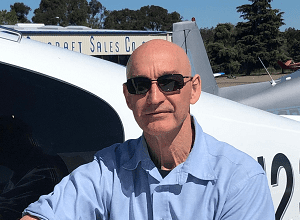Gene McCutcheon - Flight Instructor
Bay Area Flying Club
| Flight Instructor: |
CFI, CFII, MEI |
| Certificates Held: |
Airline Transport Pilot Single Engine Land, Commercial Single Engine Land, Commercial Multi Engine Land, Instrument Rated |
| Education: |
Bachelors in Public Administration |
My first flight was at the age of fourteen in a Boeing 737. It was a short hop from the San Francisco International Airport to the Stockton Airport. I remember looking down in amazement from 10,000 ft. at all the square farm fields. I knew then; I had to become a pilot. Today, many decades later, I give flight instruction over those same farm fields.
I have been very fortunate to have had a long and productive career with the City of San Francisco as a Stationary Engineer, while at the same time building many flight hours as a private, commercial, and Airline Transport pilot. In 2007 I took leave from work to complete my flight instructors training as a single engine land and instrument flight instructor. The following year I added the multi-engine land flight instructor rating.
I’ve been a flight instructor now for over 12 years, and I just love it! It is such a rewarding feeling to watch those you work with go on to become safe and knowledgeable pilots. And there’s no better place to do it than the San Francisco Bay Area with it’s diverse beauty, not so wild weather, and somewhat complex airspace–all of which makes for some great flying experiences and unmatched flight training.
5 useful questions to ask an instructor:
Why did you become a flight instructor?
Regardless of the answer, the way an instructor talks about why they fly is what is important. Look for
someone that is excited by teaching. They should have a genuine interest in giving others the gift of flight.
How long have you been flight instructing?
Some Instructors have thousands of hours under their belts and have been flight instructing for their entire
careers. Others have a few hundred and are just beginning. A seasoned instructor will have a lot of experience
but may have a set teaching style. A freshly minted instructor has less aircraft time but is able to relate to
common learning obstacles, having undergone their own flight training in the not too distant past. There are
advantages to both types of instructor.
How do you keep track of your student’s progress?
Using a syllabus is essential so that both student and instructor can track progress and milestones so make
sure your instructor uses one. Talk to other students and ask them what kind of reading their doing, what
books they’re using and the type of homework they’re getting. There should ALWAYS have some type of “homework”
assignment at the end of each lesson.
What is your availability?
Some instructors are part-time and work separate jobs during the week. Others are full-time, but may want to
have personal and family time on the weekends. Find an instructor with compatible availability. Flying at least
twice a week is the best way to progress quickly through accomplishments with less effort and less overall costs.
Choosing an instructor that is able to fly on the same schedule helps to keep flight training on a consistent path.
I’ve heard people talk about “stalling an airplane.” Can you tell me what it means?
This is a classic question. Regardless of knowing what an “aircraft stall” is or not, how an instructor explains
this concept will give great insight into how they can explain concepts. Are they patient? Do they use simple
terminology that is easy to understand? Do they ask questions to make sure their student understands, or do they
over simplify to brush off the question? Find an instructor whose instructing style is a good match.

